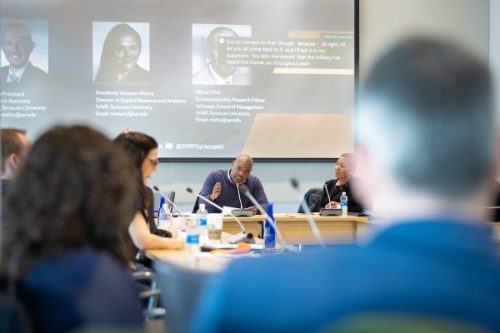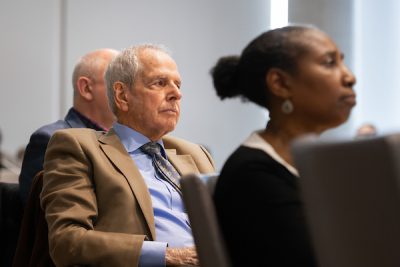Lender Center for Social Justice Symposium Examines Causes, Outcomes of Racial Wealth Gap

[ad_1]
Across hundreds of years, American society and institutions have contributed in numerous ways to creating a racial wealth gap that continues to have negative impacts throughout society.
That was the outgrowth of scholarship presented by more than 40 University faculty, students, alumni and guest presenters at the recent Lender Center for Social Justice Symposium supported by MetLife Foundation. The two-day forum held provided close examinations of structural and systemic social, economic and government factors that have contributed to an ongoing and widening wealth gap for Black, Latinx, Indigenous and other communities of color.
The event, led by Marcelle Haddix, associate provost for strategic initiatives; Gretchen Purser, interim director of the Lender Center for Social Justice; and Kira Reed, senior research associate of the Lender Center for Social Justice and co-lead of the Social Differences, Social Justice Research Cluster, also provided for discussion on ways to mitigate those factors.
The overview of wealth disparities covered the areas of law, sports, satire, humanities, the criminal legal system, writing as healing, educational systems, health care, food insecurity, access to capital and business opportunity. The research, case studies and statistics offered drew compelling pictures of the wealth gap’s impact.

More than 40 University faculty, staff, students and alumni presented over two days at the Racial Wealth Gap symposium. (Photo by Angela Ryan)
Presentations cited how:
- The average white family has more than seven times the wealth of the average Black family and five times more wealth than the average Hispanic family.
- White families are more likely to receive inheritances and other family support, such as help paying for college and down payments on homes, than are Black or Hispanic families.
- Black and Hispanic students face more stressors at home that may affect classroom behavior and the learning environment than white students do. Classrooms are also affected by the concentration of students from impoverished families.
- Black Americans still face obstructed access to education and disparities in educational quality because schools are funded based on the wealth of residential home values in a district.
- Families of incarcerated individuals often go deeply into debt to support imprisoned loved ones so the family member has enough food and can afford phone calls and other essentials the system doesn’t provide.
- Incarceration impacts family earnings and future economic security long after a sentence is served. Aside from being deprived of typical earnings, a family can’t build wealth when there are no retirement account contributions, Social Security payments, or savings deposits being made.
- The ability to access information is a strategy to develop wealth. For instance, becoming proficient at a sport—even pickleball, for instance—can provide the leverage to be admitted to a university and obtain a college education without typical out-of-pocket costs. That setting creates entrée that can produce important networking and other life opportunities.

Marvin Lender, center, who with his wife presented a gift to launch the Lender Center for Social Justice, attended the symposium and offered remarks. (Photo by Angela Ryan)
Marvin Lender, a University Life Trustee who with his wife provided the gift that helped establish the Lender Center for Social Justice, said he was impressed with the information presented and pleased with the center’s work and the University’s initiatives on social justice. “This issue is not an easy one; it is complicated and challenging. You are courageous people doing what you do to help our children and help the world,” Lender said during his remarks at the event.
Haddix said while it is very important that historical narratives are corrected, “We also need to make sure we’re documenting and bearing witness to what’s happening in contemporary times.” She asked attendees to continue their cross-disciplinary work and collaborative projects, citing the good work that faculty, staff, students and others have already done across campus.
Purser concluded, “What’s been presented today should push us to think differently. How do we create interventions to address wealth concentration? Two concepts come to mind: political will and imagination. Then the questions are: Where are we going to find the political will to address the structural inequality in our society? How can we develop the imagination to imagine a different world?”
MetLife Foundation provided the Lender Center a $2.7 million grant last fall to fund a variety of research and scholarship, community-building initiative and dialogues on the racial wealth gap.
[ad_2]
Source link
